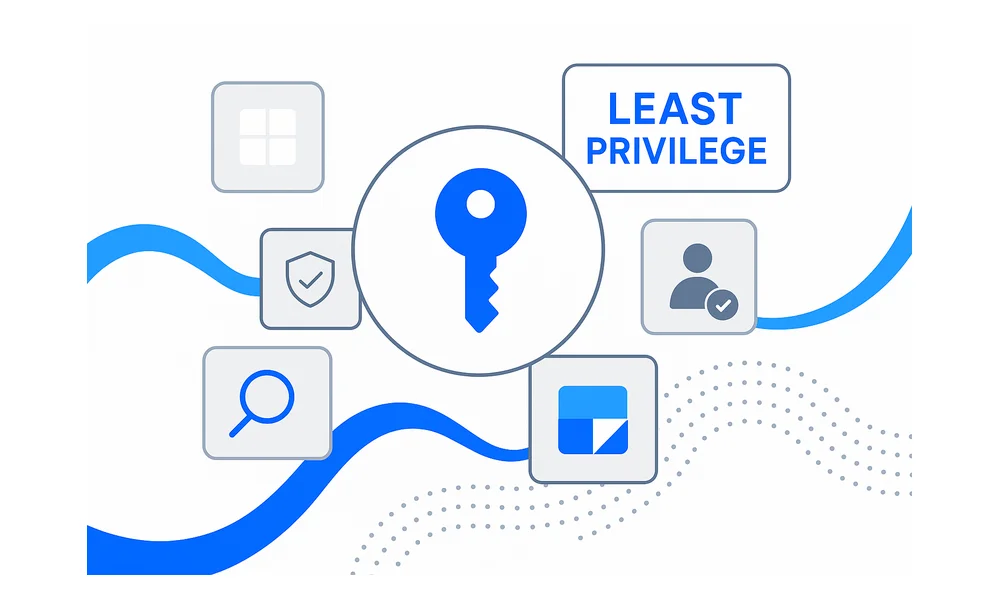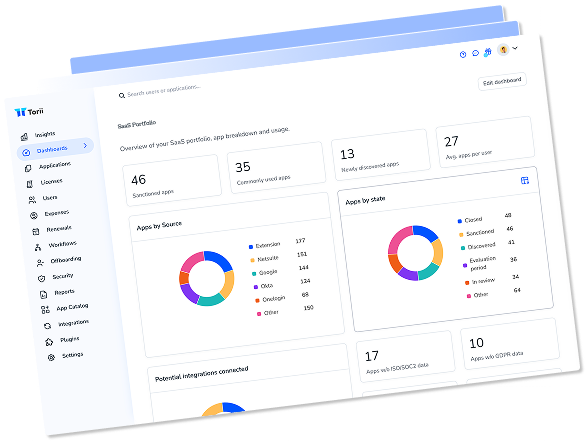What Is the Principle of Least Privilege in SaaS Environments?

SaaS tools now run most business processes and hold sensitive data across teams, increasing reliance on cloud apps for critical workflows.
That concentration raises the stakes for who can do what inside each app. The Principle of Least Privilege, which limits app-level entitlements like roles, scopes, and API tokens, reduces credential compromise and excess administrators. It also curbs persistent tokens and third-party overreach that enable lateral movement.
Rapid adoption, role churn, shadow IT, and inconsistent permission models make enforcement harder for already stretched teams. Teams now face identity sprawl, orphaned API keys, role explosion across dozens of apps, and mounting audit pressure that raises the cost of getting access wrong.
This practical guide explains how to enforce least privilege across SaaS applications and reduce access risk. It lays out why urgency comes from permission and identity sprawl and offers platform-led steps: discovery, minimal role templates, just-in-time elevation, workflow-based approvals, and periodic reviews to enforce least privilege and make access governance auditable.
Table of Contents
- What is the Principle of Least Privilege in SaaS?
- Why is enforcing least privilege harder with SaaS sprawl?
- How can SaaS management platforms enforce least privilege?
- How should teams implement and measure PoLP?
What is the Principle of Least Privilege in SaaS?
SaaS apps need per-identity permissions, not network fences, to limit damage from compromised accounts and stolen tokens.
The principle of least privilege means giving users, services, and integrations only the permissions they need to do their jobs. In SaaS environments those permissions are app-level entitlements: role assignments inside the app, OAuth scopes, API tokens, and service accounts. They differ from traditional network controls such as ports, IP allowlists, or VPN access because these permissions live inside the app and determine what data or actions an identity can reach. When entitlements are set too broadly, a single compromised account can touch many things quickly.
In practice PoLP reduces several specific SaaS risks that regularly appear in incident reports and investigations:
- Credential compromise that lets an attacker act as a real user.
- Excessive admin accounts that multiply blast radius when abused.
- Persistent API tokens and service accounts that outlive their purpose.
- Third-party apps and integrations with overly broad scopes.
Those failure modes often chain together, creating lateral movement and wide data exposure across multiple apps. Developers committing AWS keys to a public GitHub repository or accidentally leaving a Slack token in code can give attackers steady access long after the original user leaves. About half of security incidents start with stolen or misused credentials, so narrowing what each identity can do inside every SaaS product matters.
PoLP isn’t about throwing up more network walls; it’s about shrinking each identity’s reach within each application. That shifts control from the edge of your network to the entitlements inside Salesforce, Google Workspace, Slack, or any other SaaS tool. Seeing access as per-identity, per-app permissions rather than per-network rules shows why least privilege cuts real SaaS risk.

Why is enforcing least privilege harder with SaaS sprawl?
SaaS growth and modern work habits make least-privilege much harder and far more urgent than before.
Cloud-first teams now juggle dozens or even hundreds of SaaS tools, and that scale drives new risks that perimeter controls cannot address. Network firewalls and VPN rules stop helping once access is controlled by app-level roles and OAuth tokens rather than IP addresses. Many organizations run 50 to 200 apps across marketing, engineering, finance, and HR, making manual tracking of who can do what impossible without automation and governance. Remote work and contractor usage also mean access happens from unmanaged devices and home networks, which increases the chance that a single compromised account will move laterally across multiple systems.
Role churn inside agile teams compounds the problem, because job functions change faster than access lists get updated. Each new project spawns temporary roles and permissions, and those ephemeral entitlements often stick around long after the work ends. Permissions models differ wildly from app to app; Google Workspace, Microsoft 365, and Slack all label and scope admin controls differently, so a single “admin” title can mean very different powers in each system. This diversity forces security teams to translate and reconcile entitlements instead of focusing on real risk reductions.
Shadow IT and long-lived machine credentials create several concrete failure modes that surface in audits and breaches:
- Identity sprawl from duplicate, forgotten, and stale accounts that accumulate over time
- API keys and OAuth tokens that outlive users
- Third-party apps granted broad scopes during onboarding
- Unmanaged service accounts used in automation pipelines
Orphaned credentials and excessive scopes increase audit complexity and the risk of data exposure. These conditions are common vectors for breaches and often trigger compliance failures and penalties across regulated industries.
Legacy network-centric controls leave gaps, so teams need per-application entitlement governance to reduce risk and satisfy auditors. Practical enforcement, discovery, and lifecycle automation are no longer optional if organizations want to keep SaaS sprawl from becoming a major security and compliance liability.

How can SaaS management platforms enforce least privilege?
SaaS management platforms enforce least privilege by discovering apps and tying identities to exact entitlements. They correlate identities, roles, and permissions so teams can manage access precisely and reduce risky gaps across systems.
They connect to IdPs like Okta and apps such as Google Workspace to keep role assignments synced and remove manual drift. That connection lets teams treat permissions as per-app objects instead of hoping network controls will catch mistakes.
Teams should expect automated role templates, provisioning workflows, and just-in-time elevation capabilities. They automate discovery, provisioning, and cleanups so teams stop relying on spreadsheets or ad hoc scripts.
- Automated discovery builds a complete entitlement inventory across every connected SaaS app and captures who can do what and where.
- Provisioning and deprovisioning through the IdP or SCIM automates account lifecycles and eliminates manual handoffs that cause delays and errors.
- Minimal-role templates mapped to business functions prevent role explosion and keep permissions aligned with real job duties.
- Just-in-time elevation and time-bound access provide temporary permissions only when needed and automatically revoke them afterward.
- Scripted cleanup routines remove stale API tokens and orphaned service accounts on a set schedule to reduce attack surface.
- Approval workflows plus scheduled entitlement reviews enforce policy and create an auditable trail of who approved access changes.
Automation reduces simple errors and keeps access changes auditable, which lowers risk faster than manual fixes and repeated spreadsheets. Integration with HR systems like Workday can trigger access lifecycles automatically, so offboarding doesn’t rely on memory or handoffs.
Continuous monitoring and risk scoring find privilege creep and suspicious token usage quickly. Platforms ingest activity logs and flag anomalies such as a long-lived GitHub token performing repo exports or a Slack app requesting broader scopes than before, then surface those issues in a unified risk dashboard. It should be possible to forward high-risk events into a SIEM such as Splunk and run automated playbooks that revoke or quarantine access until an investigator confirms intent.
Consolidated audit trails and cross app reports make compliance evidence straightforward to collect. When access reviewers, auditors, or incident responders need answers, a single platform should show who had which role, when it changed, and what approvals existed, cutting mean time to revoke and simplifying investigations. That visibility, paired with ongoing cleanup, turns per-app entitlement governance from a headache into measurable security improvement.

How should teams implement and measure PoLP?
Treat every SaaS entitlement as inventory; discover it, label it, and assign ownership. Schedule regular classification of apps by sensitivity and map which business functions need access, because you can’t clean up what you haven’t found. Create minimal-role templates for common jobs, avoid copying broad admin roles into new apps, and require a named approver for every exception so responsibilities stay clear.
Start with a focused checklist your teams can use right away.
- Run a full SaaS and entitlement inventory that includes API tokens and service accounts.
- Classify each app by data sensitivity, and document the minimum roles needed for day-to-day operations.
- Create minimal-role templates, and map them to HR job codes.
- Automate onboarding and offboarding with SCIM via your identity provider.
- Limit access to time-bound windows and capture a business justification for any exceptions.
After that checklist, schedule quarterly entitlement reviews and assign owners who must close findings within a set SLA.
Integrate systems to cut manual steps and reduce human error, which lowers exposure. Connect your IdP and SCIM provisioning so HR-driven lifecycle events automatically add and remove access, and feed activity logs into a SIEM for continuous monitoring. Use just-in-time elevation tied to approval workflows for temporary needs, and script entitlement cleanup for orphaned accounts and stale API keys. Many teams use Okta for provisioning and link audit logs from GitHub and Slack to their SIEM to speed investigations and show clean audit trails.
Measure progress with clear numeric targets so the team can see real improvement. Track the share of users with excessive privileges and set a quarterly reduction target. Monitor orphaned credentials and stale tokens, aim for a mean time to revoke under 24 hours, and require access-review completion above 90 percent. Keep audit-ready logs and report monthly trends to show fewer entitlements and faster remediation.

Conclusion
When teams manage many SaaS tools, knowing who has access can feel urgent and become confusing quickly. That uncertainty grows as apps and identities multiply.
This article explains risks from excess app permissions and identity sprawl, and why network controls often miss those gaps. It proposes practical actions: discovery, minimal role templates, just-in-time elevation, scheduled reviews, and automation to keep entitlements tight.
Applying least privilege across SaaS through discovery, minimal role templates, just-in-time elevation, scheduled reviews, and lifecycle automation reduces app-level access risk and eases compliance.

Audit your company’s SaaS usage today
If you’re interested in learning more about SaaS Management, let us know. Torii’s SaaS Management Platform can help you:
- Find hidden apps: Use AI to scan your entire company for unauthorized apps. Happens in real-time and is constantly running in the background.
- Cut costs: Save money by removing unused licenses and duplicate tools.
- Implement IT automation: Automate your IT tasks to save time and reduce errors - like offboarding and onboarding automation.
- Get contract renewal alerts: Ensure you don’t miss important contract renewals.
Torii is the industry’s first all-in-one SaaS Management Platform, providing a single source of truth across Finance, IT, and Security.
Learn more by visiting Torii.
Frequently Asked Questions
Run a full SaaS and entitlement discovery, classify apps by sensitivity, create minimal-role templates, automate provisioning via SCIM and your IdP, enable just-in-time elevation with approval workflows, and schedule periodic entitlement reviews and scripted cleanups.
The Principle of Least Privilege gives users, services, and integrations only the app-level permissions they need: roles, OAuth scopes, API tokens, and service accounts. Limiting entitlements reduces impact from stolen credentials, excessive admins, long-lived tokens, and overbroad third-party scopes.
SaaS sprawl, role churn, shadow IT, and dozens of apps make manual privilege tracking impossible. Diverse permission models, orphaned API keys, long-lived service accounts, and transient roles cause identity sprawl and audit headaches that perimeter controls can’t fix.
SaaS management platforms discover apps and entitlements, correlate identities to roles, sync with IdPs, apply minimal-role templates, automate provisioning and JIT elevation, surface risky tokens, forward events to SIEMs, and produce consolidated audit trails for reviews and investigations.
Measure progress with concrete metrics: percentage of users with excessive privileges, number of orphaned credentials and stale tokens, mean time to revoke access, and access-review completion rate. Set quarterly reduction targets and report trends to show measurable risk reduction.
Immediately run a complete entitlement inventory, revoke or rotate stale API tokens, remove orphaned service accounts, implement minimal-role templates, enable SCIM provisioning for onboarding/offboarding, and require time-bound approvals for elevated access.

